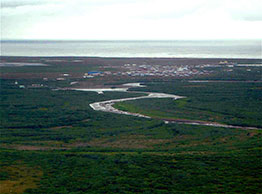Quinhagak Elders Point to Their Children's Future
Quinhagak is a Yup'ik community of about 700, located in southwest Alaska on the banks of the Qanirtuuq River where it empties into Kuskokwim Bay. In 2009, the people of Quinhagak invited the Calista Elders Council (CEC) to work with them to document their history and traditions. Their goal was to produce a bilingual book, in Yup'ik and English, that would share the traditional instructions, personal experiences, and stories of their elders for the benefit of their young people.
To reach this goal, Warren Jones and members of the Quinhagak village corporation, Qanirtuuq Inc., organized a three-day elders' gathering in Quinhagak in October, and CEC anthropologist Ann Riordan recorded what elders shared. Annie Cleveland led the discussion with elders Paul Beebe, Florence Jones, Nick and Martha Mark, Carrie Pleasant, Alice Mark, Willie Mark, Joshua Cleveland, George Pleasant, and Pauline Matthew.
At the beginning of the gathering Annie Cleveland talked to the group about the meeting's purpose. Warren Jones also attended, asking the elders to talk about detailed instructions young people should know when traveling in the mountains and on the ocean.
During the gathering, Ann Riordan had an opportunity to share a unique collection of more than 100 photographs taken in Quinhagak in the 1940s by BIA school teachers Rhoda and Bill Thomas. In 2008, Chet Williams shared these photographs with National Park Service historian, John Branson, and Katie Myers of Lake Clark National Park and Preserve. John and Katie then contacted Ann to see if she knew anyone who might be interested in the photos. The National Park Service scanned the photographs and provided Ann with digital copies, which she printed and took to Quinhagak. When Annie Cleveland announced the elders' meeting, she also told people about the album, and visitors came from early to late to look at it. Many found photos of their parents, grandparents, and themselves. It was a real treat for Ann to share such a special gift and to tell the story of how Chet gave the album to John who gave it to Katie who gave it to Ann—for them!
Returning to Anchorage, Alice Rearden set to work transcribing and translating the tapes recorded during our gathering, and Ann Riordan worked on organizing the transcripts into a bilingual book. Alice and Ann had many questions—both to find answers and to add to what had already been learned. In January 2011, Martha Mark, Joshua Cleveland, George Pleasant, and Annie Cleveland came to Anchorage for another three-day gathering supported by a grant from the National Park Service.
During 2012 Alice and Ann finished work on the bilingual book that Quinhagak elders had created through the stories they had shared. The book is titled Erinaput Unguvaniartut/So That Our Voices Will Stay Alive: Quinhagak History and Oral Traditions, and it is being published by the Calista Elders Council and the Alaska Native Language Center (due out in fall 2013).
Place names mentioned in the text, and now shared in this Atlas, were located thanks to Joseph Pleasant's 1999 booklet, "Traditional Names and Places of Native Village of Kwinhagak." Warren Jones also met with elders to provide locations for additional camps and hunting areas. Our final maps were prepared by Michael Knapp of Blue Skies Solutions in Anchorage.
Our greatest debt is to the community of Quinhagak for their energy and enthusiasm during our work together. Special thanks to Warren Jones and Annie Cleveland, both for the original invitation to work with the community and for sharing so much with us along the way.

An aerial view of Quinhagak.
Credit: Ann Riordan
